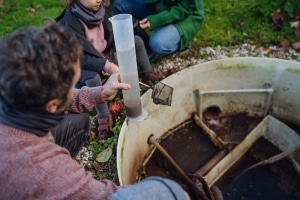Summary:
- Septic tanks are essential for homes in California that aren’t connected to municipal sewer systems.
- Septic systems are designed to process household wastewater. They separate solids and liquids, then disperse the liquid (effluent) throughout a nearby drain field to prevent groundwater contamination.
- California regulations include strict guidelines for septic tank installation, such as minimum setback distances, soil percolation rates, and site evaluations to ensure safety and environmental protection.
- Maintenance for septic tanks helps prevent them from contaminating the surrounding areas. It’s best to pump your tank every 3-5 years, conduct annual inspections, and monitor water use to avoid overloading the system.
- Signs of trouble include slow drains, foul odors, pooling water, and high nitrate levels in well water. Call professionals for help if you notice any of these.
Septic tanks are common in rural and suburban areas of California that aren’t connected to municipal sewer systems. Homes in these areas are often spaced farther apart, which makes it too expensive for many residents to extend their sewer lines.
But using a septic tank in California also means following some specific rules and regulations to prevent these systems from contaminating nearby groundwater. Below, our team of professional septic tank repair experts walks you through how a septic system works, as well as the guidelines and standards you’ll need to follow for installing, maintaining, and operating one.

Septic Tank Basics Explained
A septic tank is an underground container designed to hold the wastewater from your home. It’s usually made of concrete, fiberglass, or plastic. When you flush the toilet, run the washing machine, or use the sink, the water flows into the septic tank.
Inside the tank, solid waste sinks to the bottom, forming sludge, while oils and grease float to the top, creating a layer of scum. The liquid in the middle, called effluent, flows out of the tank into a drain field or leach field, where it gets filtered by the soil. The drain field allows the liquid to slowly seep into the ground, where the soil naturally cleans it before it reaches the groundwater.
Bacteria inside the tank break down the solid waste over time so that it takes up less space—but eventually, the sludge still builds up. When this happens, the tank needs to be pumped out by a professional to prevent it from overflowing.
Learn More: How Does a Septic System Work?

California’s Rules for Septic Tanks
Septic tanks function well when properly maintained, but they can cause problems if they’re not cared for correctly. Because of this, California has several rules and regulations that must be followed by anyone planning to install and maintain a septic system on their property.

Installation
Follow the Design & Construction Requirements
Each county has its own rules about how septic systems can be designed and built. For example, most septic tanks in San Mateo must meet the following county requirements:
- The septic system must be easy to access for maintenance and repairs.
- All parts of the septic system must be located within the property lines.
- There must be at least 3 feet of suitable soil beneath the dispersal trenches to absorb the effluent.
- Effluent dispersal is not allowed in areas with soil fill.
- Dispersal systems must have at least 12 inches of soil covering them.
- No utility lines or trenches should cross or be too close to the dispersal system.
- There must be at least 5 feet of separation between the trench bottom and the groundwater.
- The system should not be placed in areas prone to annual flooding.
- Avoid placing the system in areas subject to heavy compaction, like those with vehicle traffic or concentrated livestock.
- The slope of the land where the system is installed should not exceed 35%. Slopes over 20% require a geotechnical report (see “Conduct a Site Evaluation” below).
- The soil must allow water to percolate at a rate between 1 to 12 inches per hour.
- You’ll need to make sure your septic tank is a certain distance away from various site features (see “Minimum Setback Distances for San Mateo Septic Tanks” below).
Minimum Setback Distances for Septic Tanks (San Mateo County)
| Minimum Setback Distance (Feet) | ||
| Site Feature | To Septic Tank | To Dispersal Field |
| Building or foundation | 5 | 10 |
| Septic tank | N/A | 10 |
| Property line (properties served by wells or springs) | 50 | 50 |
| Property line (properties served by approved public water supply) | 10 | 10 |
| Swimming pool or spa | 25 | 25 |
| Road easement, pavement, or driveway | 5 | 5 |
| Watercourses (general) | 100 | 100 |
| Watercourses (between 1200 to 2500 feet from a public or State small water system intake) | 100 | 200 |
| Watercourses (Within 1200 feet downstream from a public or State Small water system intake) | 100 | 400 |
| All wells and domestic/irrigation springs | 100 | 100 |
| Public and State small water system supply wells or springs | 150 | 150 |
| Reservoirs (from high water mark) | 200 | 200 |
| Reservoirs Within 1200 feet from a public or State small water system intake | 200 | 400 |
| Groundwater interceptor trench or drain | 5 | 25 |
| Stormwater infiltration trench, gallery or well | 25 | 25 |
| Drainage ditch or swale (from edge of flow path) | 25 | 25 |
| Drainage ditch or swale with evidence of sustained wet conditions or ponding | 25 | 50 |
| Cuts or embankments (from top of cut) | 10 | 4 x the height of the cut or embankment (in feet) |
| Steep slopes with lower elevation than the septic system (under 12 feet high) | 10 | 25 |
| Steep slopes with lower elevation than the septic system (over 12 feet high) | 10 | 50 |
| Unstable land mass | 100 | 100 |
These distances may vary by county and may be updated. When you work with a qualified OWTS (On-site Wastewater Treatment System) Design Professional to plan your septic tank, they’ll contact the appropriate authorities to make sure all current setback distances are followed.
Conduct a Site Evaluation
In most areas, you’ll also have to conduct certain tests before you can apply for your permit to install a septic system.
In San Mateo county, septic tank installation requirements include a site evaluation to ensure that the proposed system will be safe. An evaluation includes:
- An inspection of the area’s general site features, including the area available for components and dispersal.
- Soil profiles conducted by a qualified OWTS Design Professional.
- A soil percolation test, which involves a County Environmental Health Certified Soil Percolation Tester visiting your property to make sure the soil where the septic tank will be installed can absorb an appropriate amount of liquid.
- A depth-to-groundwater determination to estimate the highest level of groundwater possible in both the primary and reserve areas.
- A technical analysis of the area’s slope stability if the ground slope on the site is 20% or greater.
- Additional technical studies if required (usually for non-residential and large-flow projects).
- Reports that must be submitted to Environmental Health and attached to your completed permit application.
Get the Right Permits
Once you’ve passed the required inspections, you’ll be able to apply for your permit. Every new or replacement septic tank in California needs a permit from either your local municipality or the Central Coast Water Board.
You can find out more about what office to apply through by visiting the California Water Boards Permit Information Page.
Maintenance
Once you have a septic tank installed on your property, you’ll need to make sure that it doesn’t violate certain county policies. These vary by county, but generally have the same goal: to make sure your tank doesn’t contaminate the surrounding area and create a health or safety risk.
Learn More: 5 Easy Ways to Find Your Septic Tank
Public Nuisance Violations for Septic Tanks in San Mateo County
In San Mateo, there’s no rule about exactly when you need to pump your septic tank—although we recommend doing it once every 3-5 years to prevent it from overflowing.
However, you’ll need to make sure your septic tank does not allow the contents to do any of the following:
- Flow onto the surface of any land
- Affect any well, spring, stream, river, lake, or other waters
Septic tanks must also not create any conditions deemed unsafe or dangerous by Environmental Health. If they do, they can be considered a public nuisance, and you may face penalties.
Maintenance Best Practices for California Septic Tank Owners
To avoid the above, here’s what our experts at Caccia Plumbing recommend:
- Pump out your tank every 3 to 5 years
- Have your septic tank professionally inspected annually
- Make any necessary septic tank repairs as soon as possible to prevent system failure
- Keep records of your maintenance and inspections to show compliance with local regulations
- Monitor your water use to avoid overloading the system, which can lead to failure

Calling Professionals for Help with Your Septic System
Professional repairs can help your septic system last longer, while minimizing potential health risks. This can also help you avoid fines and penalties.
When you need septic tank repair you can trust in the Burlingame or San Mateo areas, contact our team at Caccia Plumbing. We’ll be able to address issues with your system quickly and accurately so that you can continue managing your home’s wastewater responsibly and enjoy peace of mind.

